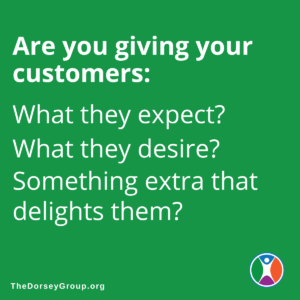Don’t ever assume: Especially when it comes to what your customers want.
Business leaders will often make statements, create policies, and set expectations for their organization based on assumptions – what they think their customers want. Without data to support these claims, their statements, processes, and policies are just guesswork.
For example, they may say, “We ship everything the same day because customers want our product as soon as possible!” The reality is that their customers don’t particularly care if they get it the next day as long as they get when they need it.
Yet the business works extremely long hours and incurs unnecessary expenses to overnight things they could package and ship the next morning without affecting customer satisfaction at all.
Take the guesswork out of pleasing customers
All customers have requirements and preferences. Things that companies do that satisfy and dissatisfy them. Using the example above, customers may not be extra satisfied because you ship overnight—that’s nice—but they may definitely be dissatisfied when they call your customer service team and get a machine or a voicemail.
Satisfiers and dissatisfiers can be broken down in two ways: the quality of product and the quality of service. There are product expectations and service expectations, and if you want to be exceptional at meeting your customer’s needs, you need to meet them on both levels, not on just one or the other.
Think about the last time you went to a restaurant and had an amazing meal, but you had to wait an hour to be seated, another hour to be served, and then your server never checked back once to see if everything was satisfactory, to refill beverages, etc. Even though the product (your meal) was exceptional, the horrible service is enough to drive you away, right? The same goes for every single kind of business in every single industry.
What does this mean for your business?
Customers set the priorities for your organization. Whatever creates value for them is what you need to deliver. A great example of this is years ago when American car builders gave customers the opportunity to customize their vehicles. The catalog allowed them to choose from a variety of engines, stereo systems, interiors, etc.
Customers had hundreds of thousands of options for how they could order their car. But then one day, Toyota entered the market with just three cars to choose from, the S (a basic model), SL (a mid-level model that might have AC and leather seats), and the SX (the luxe model with all the bells and whistles). You could pick your color, but that was as far as the customized options went. The manufacturer found that it was cheaper to build cars the same way every time. But it also worked for their customers because they could drive away the same day.
See, they had a totally different value proposition. Instead of letting you customize everything about your car, they offered you three options with the caveat that you could drive it off the lot today. You could get behind the wheel and drive away immediately after purchase.
The problem with American automakers was that they weren’t listening to the voice of the customer. They assumed that Americans wanted to customize their vehicles a certain way. So when Toyota, Honda, and their ilk offered a new value prop—more value (drive away today) at a lower price (because they were only manufacturing three types of cars) they were satisfying both business needs and the voice of their customer. And that revolutionized the American automotive industry and changed our car-buying habits forever.
Expectations, Desires and Delighters: Identifying what you must do, should do and could do
Identifying what customers expect of you, want from you, and what they may not know they want, but would be delighted to have from you, is key to meeting expectations and gaining their satisfaction. These needs can be grouped into one of three categories. Your ability to fulfill all of them is what will propel you from being an ordinary provider to an industry leader—and their preferred choice.
Take a look:
- Expected:These are the basic, unspoken needs your customer has. Delivery does not increase satisfaction, but their absence causes extreme dissatisfaction. On-time delivery is a good example. Your customers expect your packages to be delivered when you say they will be delivered. An on-time delivery doesn’t increase satisfaction because it’s expected, but a late delivery causes dissatisfaction because it didn’t meet their expectation.
- Desired:These are the things your customers actually say they want from you. These are the deliverables upon which you market yourself and compete within your industry. Satisfaction and dissatisfaction both increase and decrease by the degree to which you deliver. Cost or price, ease of use, speed, accessibility, and convenience could all be prime examples.

- Delighted:These are the special touches, the unexpected but totally delightful things you can offer to impress customers and earn “extra credit.” While they’re often unspoken (because the customer doesn’t even know they want it), these are the little things you can do to cement your company as the preferred choice for your customer. A handwritten note in your packaging, the chocolate chip cookie left in their hotel room with turndown service, attractive packaging, and gifts are just a few examples. While they may not always be easy to provide, they always have a dramatic effect on customer satisfaction.
Listen to the voice of your customer: Ask the right questions
So how do you know if something is expected, desired or delightful to your customers?
All you have to do is ask.
Surveys are a highly useful tool that an increasing number of companies are incorporating into their processes. Think about it. When you purchase something from Amazon, you get a survey that asks how your experience was. And a request for feedback usually follows a transaction on many online retail sites.
Creating and sending surveys may seem like an arduous task, but with all the automated options and service providers these days, it’s really quite simple. Whether you do it via email or include a quick “how are we doing” or “what features do you like the best” questionnaire in your packaging, asking for your customer’s opinion can provide many of the answers you’re looking for.
Knowing what your customers want isn’t an art form. It’s not magic. It’s not luck. It’s simply a process. And companies that have a process to actively pursue feedback from customers will gain the edge over their competitors.
The Dorsey Group can help unleash your team’s potential and power peak performance. For more information, contact us at www.TheDorseyGroup.org or (954) 629-5774.

